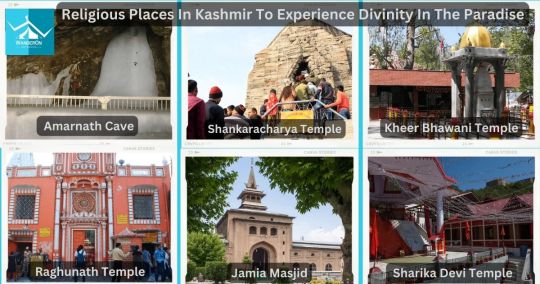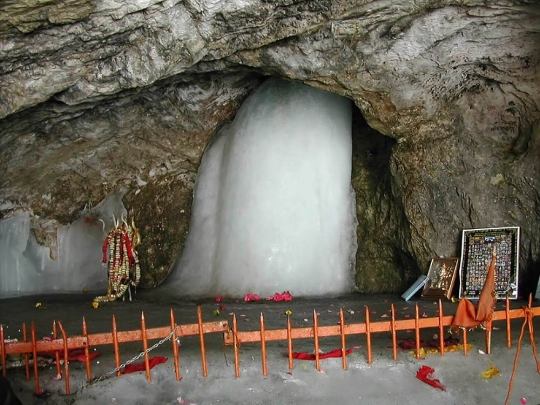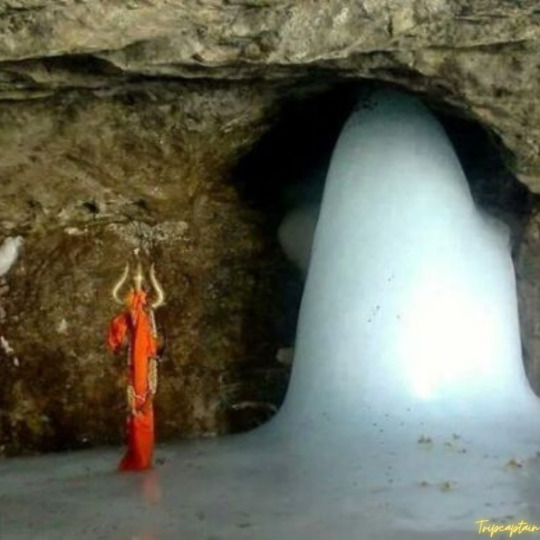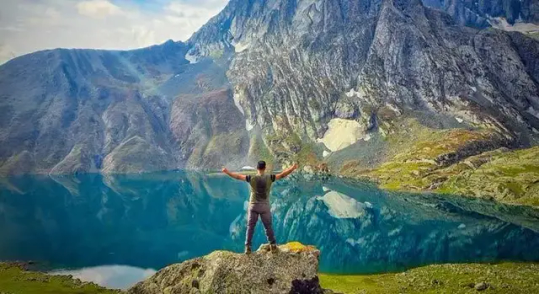#Amarnath Cave
Explore tagged Tumblr posts
Text

Explore the serene and sacred with our blog as it unveils the hidden treasures of religious places in Kashmir. Discover the spiritual essence.
#Kashmir tour packages Religious Places In Kashmir#Divinity In The Paradise#places in Kashmir#Shankaracharya Temple#Kheer Bhawani Temple#Raghunath Temple#Jamia Masjid#Sharika Devi Temple#Amarnath Cave#Vaishno Devi#Charar-E-Sharif#Martand Temple#Ziarat Dastgir Sahib
0 notes
Text
Amarnath Temple : One of India’s four main journey. The Amarnath yatra draws throngs of followers who travel across the South Kashmir Himalayas to the Holy Cave Shrine of Shari Amaranthji each year. Only in the summer, from July to August. Is the temple open to worshipers. People crowd around the ice statue of Lord Shiva that is shaped like a column called a Lingam.
am
0 notes
Text
3.75 lakh devotees performed Amaranth Yatra; another batch of 3,471 pilgrims left for Kashmir
JAMMU — Around 3.75 lakh devotees have performed the ongoing Amarnath Yatra so far as another batch of 3,471 pilgrims left for the Valley on Saturday. Officials said that since it began this year on June 29, around 3.75 lakh devotees have performed the Amarnath Yatra during the last 21 days. Over 11,000 devotees had ‘Darshan’ inside the cave shrine on Friday despite intermittent rain and…
#Amarnath Cave Shrine#Amarnath Yatra#Amarnath Yatra Pilgrims#Jammu and Kashmir (J&K)#Kashmir#Shri Amarnathji Shrine Board (SASB)
0 notes
Text
Amarnath Yatra Cave Temple: अमरनाथ गुफा में जानें से पहले भगवान शिव ने किन-चीजों का किया त्यागAmarnath Yatra Cave Temple: भगवान शिव ने अमरता की कथा सुनाने के लिए अपनी प्रिय चीजों का त्याग किया । आज के इस लेख में हम आपको बताएंगे की भगवान शिव ने अमरनाथ गुफा जाते समय किन चीजों का त्याग किया
#amarnath yatra#amaranaath gupha#bhagavaan shiv#amaranaath gupha mein jaanen se pahale bhagavaan s#amarnath yatra cave templeDharm News in Hindi#Dharm News in Hindi#Dharm Hindi News
0 notes
Text
Bro there's an Indian temple inside a cave deep in the mountains of kashmir called amarnath in which, every year, 3 shivlings (Shiva linga, is an abstract or aniconic representation of the Hindu god Shiva in Shaivism. It is typically the primary murti or devotional image in Hindu temples dedicated to Shiva, also found in smaller shrines, or as self-manifested natural objects.) made entirely out of ice formed by small drops of rainwater let in by tiny holes and cracks in the ceiling that are naturally placed at such an angle to give shape to the shivling. These shivlings start forming around april/may but it takes months for the government to clear the path and thus the tourism season starts in july, and the shivlings automatically melt a month or so after. Thousands of people travel and hike to worship this place. Isn't that cool? Indian temples rock!


114 notes
·
View notes
Text

A Hindu holy man worships a shivling representing Lord Shiva, as he waits in Jammu, India, to register for the annual pilgrimage to the Amarnath cave shrine, Monday, July 1, 2024. Thousands of pilgrims flock each year to the Himalayan shrine which contains a large icicle revered by Hindus as an incarnation of Lord Shiva, the Hindu god of destruction and regeneration. (AP Photo/Channi Anand)
6 notes
·
View notes
Text

🚨: Terrorist attack on Hindu pilgrims in Reasi district, Jammu and Kashmir, India.
In a tragic event, a group of pilgrims met with a devastating accident when their bus careened off the road and plunged into a gorge near Teryath village in the Reasi district of Jammu and Kashmir. Reports indicate that at least ten individuals lost their lives, while over 30 sustained injuries in the incident, which occurred on Sunday. The bus, returning from the Shiv Khori cave shrine to Katra, a town renowned for the Vaishno Devi temple, was traveling along a link road of NH144A, navigating through dense forests and hilly terrain. Prompt response from locals and authorities led to rescue efforts, while security forces, comprising personnel from the police, Army, and CRPF, initiated a search operation to apprehend the assailants. The area, located 100 kilometers northwest of Jammu, has been cordoned off in response to the premeditated attack. Reasi SSP Mohita Sharma disclosed that the terrorists had orchestrated the assault, targeting the bus as it passed through the area. The driver was struck by gunfire, causing the vehicle to veer off course. Evidence, including bullet casings, was recovered from the scene, indicating the involvement of two masked assailants. Although the identities of the deceased and injured have yet to be officially confirmed, it is suspected that the pilgrims hailed from Uttar Pradesh. This incident underscores the potential spread of terrorist activities into previously unaffected regions, as Reasi district had hitherto remained insulated from the surge in attacks witnessed in neighboring districts such as Rajouri and Poonch. The Pir Panjal route, notorious for its rugged terrain, serves as a favored infiltration route for terrorists moving from the Line of Control (LoC) in Poonch and Rajouri towards Kashmir. Intelligence sources suspect the participation of Illiyas Fauji, a former Pakistani army SSG commando turned LeT operative, along with two other militants from Pakistan who have evaded capture since the deadly assault on an IAF convoy in Poonch on May 4. This recent attack in Reasi follows a similar incident on May 13, 2022, when terrorists targeted a bus transporting pilgrims from Katra to Jammu using "sticky bombs," resulting in four fatalities and 13 injuries. The assault evokes memories of the July 10, 2017, attack on a bus ferrying Amarnath pilgrims, which claimed seven lives and left 19 others wounded. Despite facing heavy gunfire, the driver in that instance managed to safeguard 52 passengers. According to data from the Union home ministry, eight civilians have been killed in Jammu and Kashmir in the first five months of the current year up to May 31. Concerns regarding security have been heightened in anticipation of the upcoming Amarnath Yatra, prompting Jammu ADGP Anand Jain to oversee security arrangements on Friday night. The review encompassed preparations not only for the annual Amarnath Yatra but also for the Mata Kheerbhawani mela, Budha Amarnath Yatra, and Shri Machail Yatra, emphasizing the establishment of joint control rooms to enhance coordination among all concerned agencies. The Amarnath cave shrine, nestled at an altitude of 3,880 meters in the South Kashmir Himalayas, is slated to host its annual pilgrimage from June 29 to August 19.
#jammuandkashmir#reasi#all eyes on reasi#terrorist attack#stop terrorism#india#hindusim#pakistani terrorists#indiaunderterrorism#jammukashmir#reasidistrict#stand with reasi#stand with jammu kashmir#dead poets society#literature#poem#poetic#poetry#poets corner#poets on tumblr#writers and poets#english literature#original poem
7 notes
·
View notes
Text
Top 4 Famous Shiv Mandirs of Bharat

Famous Shiv Mandirs of Bharat
India abounds in magnificent temples dedicated to Lord Shiva, one of the most revered Hindu deities. hese ancient shrines attract millions of devotees from across the globe. The architecture, rituals and beliefs associated with these temples are fascinating.
This blog post introduces you to four of the most famous Shiv Mandirs that should be on the itinerary of every spiritual seeker in India.
Lord Shiva exemplifies the glorious history and culture of Bharat. Their grandeur, antiquity and religious significance make them architectural marvels you cannot miss.
Somnath Temple, Gujarat
One of the 12 Jyotirlingas of Lord Shiva
Believed to be first among the twelve shrines of Shiva
Destroyed and rebuilt 16 times in history
Visited by millions of devotees annually
Kashi Vishwanath Temple, Varanasi
One of the most revered Shiv mandirs
Located on the banks of Ganga river
Ancient temple rebuilt several times
Millions take holy dip in Ganga and visit the temple
Amarnath Cave Temple, Jammu & Kashmir
Famous for the natural Shivling made of ice
Located in a Himalayan cave
Draws hundreds of thousands of pilgrims yearly
Temporary temple constructed during Amarnath Yatra
Kedarnath Temple, Uttarakhand
Part of the Panch Kedar, an important pilgrimage
Located scenically in the Garhwal Himalayan range
Surrounded by snow-clad peaks, attracts devotees and tourists
As per holy books, visiting these temples and offering prayers is believed to bring good fortune and wash away sins. The ancient architecture and spiritual significance make them huge draws for pilgrims.
Donations and offerings made in these temples are utilized for operating expenses, salaries of priests, annadanam (food donation), and temple renovations. Many devotees donate money or materials for the maintenance of the mandirs.
Some FAQs on Shiv Mandirs
What are the main festivals celebrated in Shiv mandirs?
Major festivals are Mahashivratri, Shravan, and Sawan Somwar.
What types of offerings can we make in Shiv mandirs?
Common offerings are milk, water, flowers, coconut, fruits, and bilva leaves.
What are the main prayer rituals in Shiv mandirs?
Lighting diya, chanting mantras, abhishekam, arti, and circumambulating the shrine.
What should we wear while visiting Shiv mandirs?
Traditional Indian clothes, avoid shorts and sleeveless tops. So in summary, the famous Shiv mandirs of India represent the profound devotion to Lord Shiva and are architectural marvels. They allow devotees to connect spiritually and make offerings. Visiting these temples is considered highly meritorious by believers.
3 notes
·
View notes
Text
DMC For Kashmir

Kashmir, often referred to as ‘Paradise on Earth,’ is a dream destination for travelers worldwide. From the serene Dal Lake to the breathtaking meadows of Gulmarg, Kashmir offers an unparalleled experience. For travel agents and B2B tour operators looking for a trusted partner, choosing a reliable DMC for Kashmir is essential. Kashmir DMC, based in Delhi, is your go-to destination management company for crafting the perfect Jammu and Kashmir package.
Why Choose Kashmir DMC?
As a leading Kashmir DMC in Delhi, we specialize in offering customized travel solutions, ensuring that each trip is a memorable experience. Whether it’s a leisure tour, honeymoon package, corporate trip, or group travel, we handle every aspect with expertise. Our local presence in Srinagar DMC ensures seamless ground operations, from hotel bookings to guided tours.
Top Attractions in Kashmir
1. Srinagar — The Jewel of Kashmir
Srinagar, the summer capital of Jammu and Kashmir, is known for its pristine lakes, houseboats, and Mughal gardens. A visit to Dal Lake is incomplete without experiencing a Shikara ride, while the floating market adds a unique charm to the city.
2. Gulmarg — The Meadow of Flowers
Famous for its scenic landscapes and adventure sports, Gulmarg is a must-visit for skiing enthusiasts. It also boasts the highest golf course in the world, making it a paradise for nature and sports lovers alike.
3. Pahalgam — A Picturesque Retreat
Pahalgam, with its lush green valleys and the Lidder River, is ideal for trekking, camping, and adventure activities. It serves as the starting point for the Amarnath Yatra, attracting thousands of pilgrims each year.
4. Sonmarg — The Gateway to Ladakh
Sonmarg offers breathtaking views of glaciers and snow-clad mountains. It is a great destination for trekking, and its proximity to Zoji La Pass makes it a favored route for travelers heading to Ladakh.
5. Jammu — The City of Temples
Jammu, known for its sacred sites such as Vaishno Devi Temple, Raghunath Temple, and Bahu Fort, attracts pilgrims from across the globe. It is the winter capital of Jammu and Kashmir and serves as the gateway to the region.
Exclusive Kashmir Packages
1. Honeymoon Package
Romantic houseboat stays, candlelight dinners, and private sightseeing tours make Kashmir the perfect honeymoon destination. Our honeymoon packages include stays at luxury resorts and curated experiences for newlyweds.
2. Family Tour Package
Ideal for families, our package covers the best attractions in Kashmir, ensuring a mix of relaxation and adventure. Activities include pony rides in Gulmarg, sightseeing in Srinagar, and temple visits in Jammu.
3. Adventure Tour Package
For thrill-seekers, our adventure package offers skiing in Gulmarg, trekking in Sonmarg, river rafting in Pahalgam, and much more. Experience the adrenaline rush of Kashmir’s rugged terrain.
4. Pilgrimage Tour Package
Our pilgrimage tours cover the sacred sites of Jammu and Kashmir, including Vaishno Devi, Amarnath Cave, and Shankaracharya Temple, ensuring a seamless and spiritual journey.
5. Corporate and Group Travel
We specialize in organizing MICE (Meetings, Incentives, Conferences, and Exhibitions) tours for corporate groups, providing end-to-end services such as accommodation, transportation, and event planning.
Why Work with Kashmir DMC?
Local Expertise: With a strong presence as a Srinagar DMC, we offer authentic experiences and deep local insights.
Customizable Packages: Tailor-made Jammu and Kashmir packages to suit different budgets and preferences.
Trusted Partnerships: We collaborate with leading hotels, transport services, and guides to provide top-quality service.
24/7 Support: Dedicated customer support ensures smooth travel experiences for our clients.
Exclusive B2B Deals: As one of the top Kashmir B2B tour operators, we offer competitive pricing and special discounts for travel agents.
Book Your Kashmir Package Today!
If you’re looking for the best DMC for Kashmir, trust Kashmir DMC to create unforgettable travel experiences. Whether you’re planning a honeymoon, family trip, adventure tour, or corporate event, we have the perfect Kashmir package for you. Contact us today and let’s make your dream journey a reality!
www.kashmirdmc.co.in
#kashmir dmc#kashmir dmc package#srinagar dmc#kashmir tour package#kashmir b2b tours#kashmir trip package#kashmir b2b tour operators#kashmir dmc in india
0 notes
Text
Reach Baba Barfani easily with Dazonn Travels! Visit the holy Amarnath cave, home to the sacred ice Shivlinga. Our travel packages ensure a safe and comfortable journey with expert guidance. Experience peace and stunning Himalayan views. Book your trip today with Dazonn Travels and make it a memorable pilgrimage. For more Details visits our Website or Contact us now: 896-872-7340
0 notes
Text
Amarnath Temple : Information About

The Amarnath Temple nestled in the Himalayas of Jammu and Kashmir, India, holds profound religious significance for Hindus worldwide. Dedicated to Lord Shiva, the temple annually attracts thousands of devotees during the Amarnath Yatra pilgrimage, which takes place during the summer months. The journey to the temple involves a challenging trek through breathtaking landscapes, often covered in snow, making it both a spiritual and physical endeavor. The temple itself houses a naturally formed ice Shiva Linga, which is believed to symbolize Lord Shiva's presence. This natural phenomenon has captured the imagination of devotees for centuries, and the Amarnath temple complex continues to be a site of deep devotion and awe-inspiring natural beauty.
0 notes
Text
Over 3.65 lakh pilgrims performed Amarnath Yatra so far; 4,821 Yatris left for Kashmir
JAMMU — Over 3.65 lakh pilgrims have so far performed the annual Amarnath Yatra as another batch of 4,821 Yatris left for Kashmir on Friday. Since it started on June 29, a total of 3.65 lakh Yatris had ‘darshan’ inside the holy cave shrine so far. Over 14,000 pilgrims arriving both from Baltal and Pahalgam routes had ‘darshan’ on Thursday, officials said. “Another batch of 4821 Yatris left…
#Amarnath Cave Shrine#Amarnath Yatra#Amarnath Yatra Pilgrims#Jammu and Kashmir (J&K)#Kashmir#Shri Amarnathji Shrine Board (SASB)
0 notes
Text
Trekking in Kashmir: Best Trails for Nature and Adventure Lovers

Kashmir, often called "Paradise on Earth," offers some of the most stunning trekking opportunities in the world. With its unspoiled beauty, lush meadows, alpine lakes, and snow-clad peaks, the region is a haven for trekking enthusiasts. Whether you're an experienced trekker or a beginner, Kashmir's trekking routes promise a journey filled with awe-inspiring landscapes and unforgettable memories.
Why Trekking in Kashmir is Unique
Trekking in Kashmir is unlike any other experience. The trails here are adorned with verdant valleys, shimmering lakes, and breathtaking mountain vistas. The region’s diversity allows you to choose from easy hikes to challenging high-altitude expeditions, each offering a glimpse of Kashmir’s pristine beauty and cultural richness.
Top Trekking Routes in Kashmir
1. The Great Lakes Trek
The Great Lakes Trek is undoubtedly one of the most iconic treks in Kashmir. It takes you through a series of seven mesmerizing alpine lakes, each more beautiful than the last.
Distance: Approximately 70 km
Duration: 6-8 days
Highlights:
Crystal-clear lakes like Vishansar, Krishansar, Gadsar, and Gangbal.
Panoramic views of snow-capped peaks and flower-filled meadows.
Shepherd huts and grazing sheep dotting the landscape.
Difficulty: Moderate to challenging.
Best Time to Visit: June to September, when the snow has melted, revealing the lush greenery.
2. Tarsar Marsar Trek
Known for its twin lakes, Tarsar and Marsar, this trek is a perfect blend of adventure and serenity.
Distance: Approximately 48 km
Duration: 6-7 days
Highlights:
Camping by the pristine Tarsar Lake under a star-lit sky.
Traversing through lush green meadows, quaint villages, and streams.
Spectacular views of the Aru Valley and Kolahoi Glacier.
Difficulty: Moderate.
Best Time to Visit: July to September.
3. Kolahoi Glacier Trek
This trek is ideal for those looking to explore Kashmir’s rugged beauty and majestic glaciers.
Distance: Approximately 26 km
Duration: 3-4 days
Highlights:
The dramatic Kolahoi Glacier, the largest in Kashmir.
Scenic views of the Lidder Valley and surrounding peaks.
Encounters with nomadic Gujjar and Bakarwal communities.
Difficulty: Moderate.
Best Time to Visit: May to October.
4. Yusmarg Trek
Yusmarg, known as the "Meadow of Jesus," is a serene and relatively unexplored trekking destination.
Distance: Variable (easy day treks or overnight camping options).
Highlights:
Picturesque meadows and dense pine forests.
The Doodh Ganga River with its milky white waters.
Perfect for short, easy treks and camping trips.
Difficulty: Easy.
Best Time to Visit: April to November.
5. Amarnath Cave Trek
A spiritual yet adventurous journey, the trek to Amarnath Cave is one of the most revered pilgrimages in India.
Distance: 36-48 km (depending on the route).
Duration: 4-5 days
Highlights:
The sacred ice Shiva Lingam inside the Amarnath Cave.
Scenic routes via Pahalgam or Baltal, each offering unique experiences.
A mix of spiritual and natural beauty.
Difficulty: Moderate to challenging.
Best Time to Visit: June to August, during the Amarnath Yatra season.
Preparing for a Trek in Kashmir
Fitness: Many treks in Kashmir involve high altitudes and challenging terrains. Physical fitness is essential for a comfortable trekking experience.
Gear: Invest in good-quality trekking shoes, warm clothing, a backpack, and other essentials like a sleeping bag and trekking poles.
Permits: Some trekking routes require permits, especially if they pass through wildlife reserves or sensitive areas. Ensure you have the necessary documentation.
Guides and Porters: Hiring a local guide can enhance your experience, as they are familiar with the terrain and can share valuable insights about the region.
Acclimatization: High-altitude trekking requires time to acclimatize to prevent altitude sickness. Plan your trek accordingly.
Best Time for Trekking in Kashmir
The ideal trekking season in Kashmir is from June to September, when the snow has melted, and the valleys are in full bloom. Autumn treks (October to November) offer a different kind of beauty, with golden hues dominating the landscapes.
Safety Tips for Trekking in Kashmir
Always trek with a group or a certified guide.
Carry a first-aid kit and basic medicines.
Stay hydrated and carry sufficient water.
Avoid littering and respect the local environment and culture.
Keep an eye on weather forecasts and be prepared for sudden changes.
Cultural Insights Along the Trekking Trails
Trekking in Kashmir also offers a chance to immerse yourself in the region’s unique culture. Encounter traditional Kashmiri villages, interact with hospitable locals, and witness their way of life. Don’t miss tasting local delicacies like Rogan Josh, Kahwa, and Gushtaba during your journey.

Conclusion
Trekking in Kashmir is not just an adventure; it’s an experience that stays with you forever. The region’s unmatched natural beauty, combined with its serene environment and challenging terrains, makes it a dream destination for trekkers. Whether you’re exploring the azure alpine lakes, walking through lush meadows, or standing atop a mountain peak, every moment in Kashmir feels like magic.
#TrekkingInKashmir#KashmirTrek#GreatLakesTrek#TarsarMarsarTrek#KolahoiGlacierTrek#YusmargMeadows#AmarnathTrek#ParadiseOnEarth#KashmirAdventures#AlpineLakesKashmir#ExploreKashmir#HimalayanTrekking#NatureLoversParadise#HikingInIndia#MountainAdventures#ScenicTrails#KashmirDiaries#WanderlustKashmir#KashmirCalling#TrekkingGoals#AdventureAwaits#HiddenGemsKashmir#HighAltitudeTrek#MeadowTrails#TravelInspiration
0 notes
Text

June 2023: Jammu, India Hindu holy men stand in a queue to register for the annual Amarnath pilgrimage. The Amarnath Yatra pilgrimage is held annually to the holy Amarnath cave, dedicated to Hindu god Shiva
Photograph: Channi Anand/AP
2 notes
·
View notes
Text
Holy Amarnath Dham
Amarnath caves hold Hindu beliefs in Lord Shiva from 5000 years. It is 40 m (130 ft) high and 90 ft long cave in Himalayan glacial valley. Ice incrustation hererepresents Shiva in the form of Shivlinga. The shape and size of it changes with phases of the moon.
Geographically, the Holy Amarnath Dham is positioned in a narrow gauge at the farthest side of Lidder valley. It is elevated at a height of 3,888 meters above sea level and is located about 141 km East of Srinagar, and, merely 46km away from Pahalgam.
History of Amarnath Cave
Known as the pious cave associated with Lord Shiva and Goddess Parvati, Amarnath cave is the most stunning location spreading heavenly bliss. As per the legends are to be believed about Amarnath Cave history, Goddess Parvati once asked about the skull bead garland, answering to her inquisition Lord Shiva told, whenever Pravati came back to new life he increase a bead in the chain. Then, Parvati said, I died and my body was destroyed every time but my Lord you remain immortal. What is the secrete of this? Shankarji smiled and answered that is due to Amar Katha.” She requested to narrate the story to her too.
Shivji chose the Amarnath Dham to narrate Amar Katha to Goddess Parvati as it was in lonely area. As he moved towards the cave, Lord Shiva left Nandi at Pahalgam, his moon at Chandanwadi, his snakes at the bank of Lake Sheshnaag, his son Lord Ganesha at Mahagun Parvat and five elements (air, water, fire, earth and sky) at Panjtarini. In the wake of narrating it, he spread the deer skin asan, ignited Kalagni and destroyed everything living around the cave with it; so that no one can hear the story. But, as the luck would have it, an egg beneath the asan was protected by Shiva-Parvati in disguise. It heard the story of immortality then. The pair of pigeons born from it became immortal. From there on, Lord Shiva has started residing there in the form of an ice Shiva Lingam.
Who discovered Amarnath Cave?
There are couple of stories considering the discovery of Amarnath cave which have been mentioned already in Puranas. According to a legend, in the Kal Yuga, this cave was rediscovered by a shepherd named Buta Malik in 15th century. As the story describes, once Buta Malik met a saint, who gave him a pot full of coal. On returning home, he discovered that the coal transformed into gold. In the wake of happiness, he ran back to thank the saint. There, he could not find the saint. In turn, he got to see an ice Shiva Lingam in the cave of that saint. From there on, the news got spread and it became a place of pilgrimage for Hindus.
Another fable says, the Kashmir was under flood like situation then, Kashyap Rishi channelized water in rivers and tributaries. When Bhrigu Rishi was on the way to Himalayas he was the visitor to this holy Amarnath Dham and the Lingam. Later as the news about ice Shivalinga spread devotees too flock to this incredible terrain to carry out the pilgrimage since then for eternal bliss.
0 notes
Text
Discovering the Sacred Amarnath Yatra Tour Destinations
The Amarnath Yatra, one of India’s most revered pilgrimages, takes devotees through breathtaking landscapes and spiritual landmarks. Nestled in the Himalayas, the Amarnath Cave is a sacred site dedicated to Lord Shiva, attracting thousands of pilgrims annually. Each stop on this journey is steeped in spirituality and natural beauty, making the Yatra an unforgettable experience.
For more information please visit - Tour to Amarnath Yatra
Baltal: The Gateway to Amarnath
Baltal serves as one of the primary base camps for the Amarnath Yatra. Located about 15 kilometers from the holy cave, this route is favored for its shorter trekking distance. The trail, though steep, offers stunning views of the surrounding mountains and valleys. Baltal also provides helicopter services for devotees who prefer a quicker journey. Pilgrims can immerse themselves in the serenity of this place before beginning their ascent to the sacred shrine.
Pahalgam: A Picturesque Starting Point
Another popular base camp for the Yatra is Pahalgam, a scenic town in Jammu and Kashmir. Known for its lush greenery, gushing rivers, and tranquil atmosphere, Pahalgam is a destination in itself. The route from Pahalgam to the Amarnath Cave is longer but less challenging, making it a preferred choice for many devotees. Along the way, pilgrims pass through quaint villages, ancient temples, and pristine meadows, all adding to the spiritual ambiance of the journey.
Chandanwari: Nature’s Haven
Chandanwari, situated 16 kilometers from Pahalgam, is the first major stop on the traditional Amarnath Yatra route. Surrounded by snow-capped peaks, this spot is famous for its natural beauty and serves as an ideal place for acclimatization. The pristine Sheshnag River flows through this area, enhancing its charm. Chandanwari is also known for the snow bridge that pilgrims cross during their trek, a unique and memorable experience.
Sheshnag: The Mythical Lake
Sheshnag, located about 12 kilometers from Chandanwari, is a high-altitude lake named after the serpent deity Sheshnag. According to Hindu mythology, this lake is believed to be the abode of the divine serpent. The turquoise waters of the lake, surrounded by towering mountains, create a mystical atmosphere. Pilgrims often rest here overnight, offering prayers and soaking in the spiritual energy of the place.
Panchtarni: The Final Stop Before the Cave
Panchtarni, situated at the confluence of five streams, is the last stop before reaching the Amarnath Cave. Located approximately 6 kilometers from the shrine, this spot is a serene and picturesque campsite. The panoramic views of the Himalayas and the soothing sound of flowing water make Panchtarni a tranquil retreat for weary travelers. Pilgrims often spend the night here to prepare for the final leg of their journey.
The Amarnath Cave: A Divine Encounter
The ultimate destination of the Yatra is the sacred Amarnath Cave, where the naturally formed ice lingam of Lord Shiva is enshrined. This miraculous formation is a symbol of divine energy and is said to wax and wane with the phases of the moon. The cave’s spiritual significance is further heightened by the legends surrounding it, including the story of Lord Shiva revealing the secrets of immortality to Goddess Parvati here. The serene and otherworldly atmosphere inside the cave leaves devotees spellbound.
Spiritual and Scenic Splendor
The Amarnath Yatra is not just a pilgrimage but also a journey through some of the most stunning landscapes in the Himalayas. From verdant valleys and glistening rivers to snow-covered peaks and tranquil meadows, every step of the trek offers a visual and spiritual treat. The camaraderie among fellow pilgrims, the chants of “Har Har Mahadev,” and the sense of devotion create an unparalleled experience.
Preparing for the Yatra
Undertaking the Amarnath Yatra requires careful preparation. Pilgrims must register in advance and obtain a compulsory health certificate. Suitable clothing, sturdy footwear, and essential supplies like food, water, and medications are a must. The high-altitude trek demands good physical fitness and acclimatization to prevent altitude sickness. Despite the challenges, the spiritual rewards of the Yatra make every effort worthwhile.
Best Time to Visit
The Amarnath Yatra is usually conducted during the months of July and August, coinciding with the Shravan month of the Hindu calendar. This period is considered highly auspicious and offers relatively stable weather conditions for the trek. However, the unpredictable Himalayan climate necessitates vigilance and flexibility in travel plans.
Conclusion
The Amarnath Yatra is a journey of faith, resilience, and discovery. Each destination along the route holds a unique charm, blending natural splendor with spiritual significance. Whether you start from Baltal or Pahalgam, the path to the holy cave is filled with moments of awe and inspiration. For those seeking a deeper connection with the divine amidst the majesty of nature, the Amarnath Yatra is a pilgrimage like no other.
#AmarnathYatra#SpiritualJourney#AmarnathCave#LordShiva#HimalayanPilgrimage#BaltalRoute#PahalgamRoute#SheshnagLake#Panchtarni#SacredDestinations#HinduPilgrimage#ShravanMonth#SpiritualTravel#DivineExperience#IndianPilgrimage#swastik holiday
0 notes